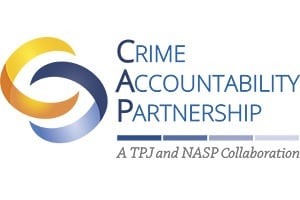Sponsored by Crime Accountability Partnership
Retailers are losing their traditional allies in the fight against shoplifting. Once part of a multi-prong crime control effort—which included courts, communities, and law enforcement—retailers are increasingly fighting the battle on their own. Pulled in other directions and driven by other priorities, these former partners in crime prevention have become increasingly willing to see shoplifting as a retailer’s problem.
“You can see it in the criticism of big retailers who ‘call police too much,’” said Barbara Staib, director of communications for the National Association for Shoplifting Prevention (NASP). “It shows a significant change in the mindset toward shoplifting—that retailers would face criticism for calling law enforcement when they are the victims of crime.”
The criminal justice system, too, is stepping away from its traditional role in shoplifting prevention. In some communities, there is simply neither the will nor the resources to provide meaningful reform opportunities to shoplifters. At the same time, a movement to reduce incarceration has gained momentum. “It’s understandable because the system is not in good shape, but there is a trickle-down effect,” explained Staib. “The result is a criminal justice system that can’t effectively sanction misdemeanor crime and the result is the de facto decriminalization of shoplifting.”
Shoplifting already accounts for almost 20 percent of all thefts in the United States, according to US Department of Justice data. With courts and police assuming less responsibility for its prevention, that figure could grow.
“This lack of accountability for offenders is a dangerous thing—for retailers and for communities,” Staib warned. “We know that for a shoplifter the most important factor in a decision to steal again is what [repercussions] they experienced the time before. And if they got away with it, or the retailer simply let them go, or if the criminal justice system let the case go, then they are more likely to do it again.”
“As far as a message to the shoplifter and preventing recidivism, warn-and-release doesn’t work; in fact, it empowers offenders to do it again.” said Staib. “Education offers retailers their best hope to reduce the number of people who shoplift in their stores and to reduce the cost of repeat offenders—and it frees them to focus on professional criminals and strategies to reduce organized retail crime.”
So what does work?
“What’s important with any program is that it makes you confront why you did it and provides time for carefully guided evaluation of their poor choices and resulting actions,” explained Staib.
NASP’s educational approach is helping to drive success of the new Crime Accountability Partnership Program, a joint effort between NASP, which has a long tradition of providing proven-effective anti-shoplifting education, and Turning Point Justice, an advanced technology company with loss prevention expertise. The program has attracted a long and impressive list of retail clients as well as widespread law enforcement and public sector support.
Under the program, which is free to retailers, first offenders who qualify—based on parameters set in partnership with local law enforcement—stay out of the court system by paying the cost of the program, including restitution to the retailer, and participating in an education program administered by NASP using the same programs and methods they use to serve courts across the country.
Offense-specific education programs affect behavioral changes in a way that civil demand alone may not, according to Staib. “A civil fine can be painful, but it’s over quickly. It’s done and forgotten, and they don’t think about it again. It does nothing to make shoplifters think about why they shoplifted in the first place, and, more importantly, why they don’t want to shoplift again,” she said.
“The program is about the offender. It’s about helping them look at why they are in this position because they don’t see themselves as criminals, and most of them are otherwise law-abiding citizens,” explained Staib. “Most shoplifters are people who would run behind you to hand you a $20 bill you dropped.” While there are people who will always steal, “there are many more whom we can influence to change their behavior through programs that include sanctions that are proportionate to their crime and include education,” she added.
Rarely driven by criminal intent, these individuals are typically reacting to an opportunity within a vacuum of understanding about shoplifting and themselves. Over the course of four hours, in a correspondence-style course of 30-minute segments completed online or by mail, offenders have an opportunity to gain insight into their actions and begin to understand why they took such a big risk for so small a reward.
“When it’s just me and my workbook, I have to engage. I can’t rely on others in a classroom setting to do the work for me,” said Staib. Given that time for reflection, students are able to humanize victims of shoplifting and come to see the risk that shoplifting poses to their own best interests. Instead of externally focused exercises like creating a family budget—a largely meaningless activity that some programs require—an education program that is capable of permanently altering behavior will “keep forcing attention back on the offender,” explained Staib.
Looking ahead
The future of shoplifting is unclear. Some signs suggest there is reason to be pessimistic, including survey data that indicates the social stigma of shoplifting is weakening. (In 1979, only 10 percent of people said they knew others who shoplift; in 2007, it had grown to 60 percent.) Other indicators offer hope, however, including the evidence that quality alternative education programs can cut recidivism rates to as low as 2.9 percent.
With the reduction in public sector support to reduce recidivism, where shoplifting rates go from here is largely in the hands of retailers. Proven effective and offense specific education programs work, but it requires the retail industry to be committed to making use of them.
According to Staib, two facts about non-professional shoplifters are key to education’s promise to reduce shoplifting: they are rarely driven by criminal intent, and no one wants to make their life harder than it already is. “Providing them with tools to change their behavior and immediately improve their lives will likely have a huge impact—on both their future and the retailers’,” she said. “The most common comment from offenders court-ordered to complete a NASP program is, ‘Had I known all of this before, I never would have done it.’”
This post was originally published in 2017 and was updated April 16, 2018.



